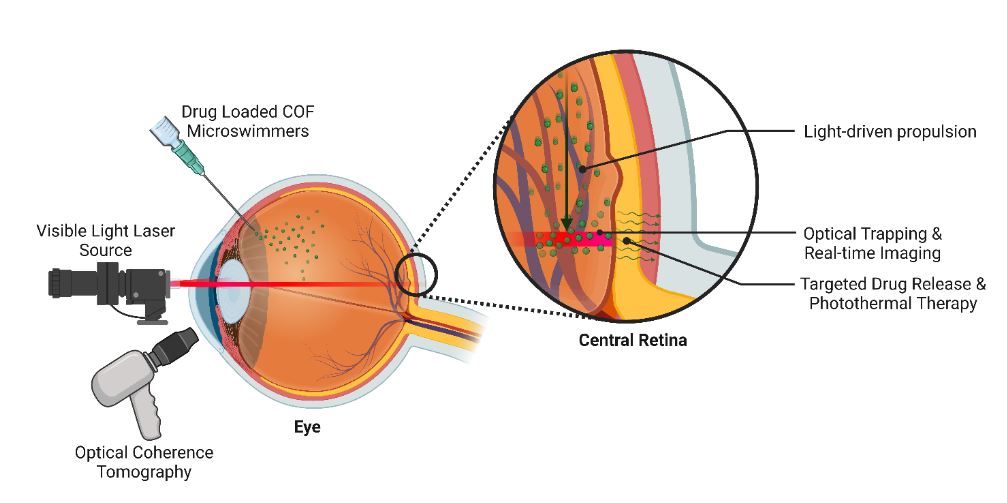Designing Covalent Organic Framework-based Light-driven Microswimmers towards Intraocular Theranostic Applications

While micromachines with tailored functionalities enable therapeutic applications in biological environments, their controlled motion and targeted drug delivery in biological media require sophisticated designs for practical applications. Covalent organic frameworks (COFs), a new generation of crystalline and nanoporous polymers, offer new perspectives for light-driven microswimmers in heterogeneous biological environments including intraocular fluids, thus setting the stage for biomedical applications such as retinal drug delivery. Two different types of COFs, uniformly spherical TABP-PDA-COF sub-micrometer particles and texturally nanoporous, micrometer-sized TpAzo-COF particles are described and compared as light-driven microrobots. They can be used as highly efficient visible-light-driven drug carriers in aqueous ionic and cellular media. Their absorption ranging down to red light enables phototaxis even in deeper and viscous biological media, while the organic nature of COFs ensures their biocompatibility. Their inherently porous structures with ≈2.6 and ≈3.4 nm pores, and large surface areas allow for targeted and efficient drug loading even for insoluble drugs, which can be released on demand. Additionally, indocyanine green (ICG) dye loading in the pores enables photoacoustic imaging, optical coherence tomography, and hyperthermia in operando conditions. This real-time visualization of the drug-loaded COF microswimmers enables unique insights into the action of photoactive porous drug carriers for therapeutic applications.
| Author(s): | Sridhar, Varun and Yildiz, Erdost and Rodrı́guez-Camargo, Andrés and Lyu, Xianglong and Yao, Liang and Wrede, Paul and Aghakhani, Amirreza and Akolpoglu, Mukrime Birgul and Podjaski, Filip and Lotsch, Bettina V and Sitti, Metin |
| Journal: | Advanced Materials |
| Volume: | 35 |
| Number (issue): | 25 |
| Year: | 2023 |
| Project(s): | |
| Bibtex Type: | Article (article) |
| DOI: | 10.1002/adma.202301126 |
| State: | Published |
| Article Number: | 2301126 |
| Electronic Archiving: | grant_archive |
| Talk Type: | https://doi.org/10.1002/adma.202301126 |
BibTex
@article{sridhar2023designing,
title = {Designing Covalent Organic Framework-based Light-driven Microswimmers towards Intraocular Theranostic Applications},
journal = {Advanced Materials},
abstract = {While micromachines with tailored functionalities enable therapeutic applications in biological environments, their controlled motion and targeted drug delivery in biological media require sophisticated designs for practical applications. Covalent organic frameworks (COFs), a new generation of crystalline and nanoporous polymers, offer new perspectives for light-driven microswimmers in heterogeneous biological environments including intraocular fluids, thus setting the stage for biomedical applications such as retinal drug delivery. Two different types of COFs, uniformly spherical TABP-PDA-COF sub-micrometer particles and texturally nanoporous, micrometer-sized TpAzo-COF particles are described and compared as light-driven microrobots. They can be used as highly efficient visible-light-driven drug carriers in aqueous ionic and cellular media. Their absorption ranging down to red light enables phototaxis even in deeper and viscous biological media, while the organic nature of COFs ensures their biocompatibility. Their inherently porous structures with ≈2.6 and ≈3.4 nm pores, and large surface areas allow for targeted and efficient drug loading even for insoluble drugs, which can be released on demand. Additionally, indocyanine green (ICG) dye loading in the pores enables photoacoustic imaging, optical coherence tomography, and hyperthermia in operando conditions. This real-time visualization of the drug-loaded COF microswimmers enables unique insights into the action of photoactive porous drug carriers for therapeutic applications.},
volume = {35},
number = {25},
year = {2023},
slug = {sridhar2023designing},
author = {Sridhar, Varun and Yildiz, Erdost and Rodr{\'\i}guez-Camargo, Andr{\'e}s and Lyu, Xianglong and Yao, Liang and Wrede, Paul and Aghakhani, Amirreza and Akolpoglu, Mukrime Birgul and Podjaski, Filip and Lotsch, Bettina V and Sitti, Metin}
}








